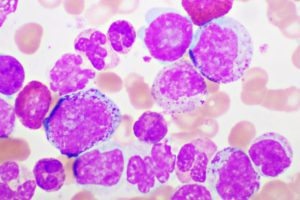- Polycystic ovarian syndrome (PCOS) is a heterogeneous disorder affecting up to 5-10% of women of reproductive age (15-44 years) often associated with obesity, acne, excess hair growth in face and body and menstrual irregularity causing fertility problems
- The term Polycystic Ovarian Syndrome means enlarged ovaries with presence of multiple small cysts and absence of any other causes of polycystic ovaries.
- PCOS is a multifactorial disease with an excess in the production of androgen hormone by the ovaries that interferes with the reproductive, endocrine and metabolic functions.
- It is the most common endocrine or hormonal disorder in women of childbearing age that affects 1 in 10 women.
- PCOS is also the leading cause of infertility in female (approximately 75% women with PCOS develops infertility as complication)
- Its incidence is fast increasing due to change in lifestyle and stress
Pathophysiology
The exact cause of PCOS is not known for certain.
It is believed that excess androgen production (hyperandrogenism) and insulin resistance are linked to the development of PCOS as they create hypothalamic-pituitary-ovarian axis abnormality
- Hyperandrogenism
- PCOS affects the ovaries that produce estrogen and progesterone and also small amounts of androgens. Excessive production of these hormones causes irregular menstrual cycle.
- Due to abnormal production of a hormone called Gonadotropin releasing hormone (GnRH) from the pituitary gland, the level of Luteinizing hormone (LH) rises up and follicular stimulating hormone (FHS) level drops. Rise in LH causes an increase in the production of testosterone.
- In PCOS syndrome, several fluid filled sacs develop inside the ovaries hampering their function and causing release of immature eggs that do not mature enough to induce ovulation.
- Due to lack of ovulation, the usual level of estrogen and progesterone reduces below normal and the level of androgen increases thus creating a hormonal imbalance and irregularity in menstrual cycle.
- Insulin resistance
- Suppresses synthesis of sex-hormone binding globulin (SHBG)
- Increases adrenal and ovarian synthesis of androgen, thereby increasing androgen levels
Clinical features
- Irregular menstrual cycle
- Delayed menarche
- Oligomenorrhea
- Amenorrhoea
- Heavy bleeding
- Hyperandrogenism
- Male pattern baldness
- Deep voice
- Excess hair growth in unwanted areas (Hirsutism) such as the face, chest, back, or buttock
- Hair loss or thinning of hair
- Acne or oily skin
- Others:
- Darkened skin (acanthosis nigricans) on the neck and skin flexures reflect hyperinsulinemia
- Sleep disturbances
- Weight gain
- Subfertility
- Tiredness
- Headaches
Risk factors
- Genetic factors – The risk of developing PCOS is often increased if it runs in the family, such as mother, sister or aunt.
- Pituitary dysfunction
- Obesity
- Hyperglycaemia
- Insulin resistance
- Hypertension
- Dyslipidemia
- Drugs (such as Valproic acid)
Diagnosis
By Rotherdam criteria (2 out of 3 must be present)
- Polycystic ovaries (12 or more follicles or ovarian volume more than 10 cubic cm most readily detected by transvaginal ultrasound);
- Menstrual irregularity; Oligo-ovulation or anovulation
- Clinical or / and biochemical signs of hyperandrogenism
Differential diagnosis
- Cushing syndrome
- Prolactin disorders
- Thyroid disease
- Androgen secreting tumor
- Congenital adrenal hyperplasia
- Acromegaly
- Genetic defects in insulin action
- Primary ovarian failure
- Primary hypothalamic amenorrhea
Investigations
- Hormonal assay
- Follicle-stimulating hormone (FSH)
- Luteinizing hormone (LH)
- LH:FSH ratio
- Testosterone
- Estrogens
- Progesterone
- Sex hormone binding globulin (SHBG)
- Androstenedione
- Human chorionic gonadotropin (hCG)
- Anti-Mullerian hormone (AMH)
- Blood tests to exclude other causes
- Lipid profile
- Serum prolactin
- Thyroid function
- Blood glucose
- Imaging
- USG/TVS
- Diagnostic test showing 12 or more follicles each of 2-3 mm in size placed peripherally
- It can rule out ovarian tumor
- It can detect endometrial hyperplasia if present
- CT/MRI to rule out tumors
- USG/TVS
Complications
- Pregnancy complications
- Infertility
- Miscarriages
- Spontaneous abortion
- Gestational diabetes
- Metabolic effects and Cardio-vascular complications
- Type 2 diabetes
- glucose intolerance
- non-alcoholic fatty liver disease
- Heart diseases
- Stroke
- Dyslipidemia
- Hypertension
- Psychological effects
- Depression or mood-swings
- Anxiety
- Sleep apnea
- Cancer
- Chances of developing endometrial hyperplasia or cancer if there is less than 3 or 4 periods a year
Management
Goals
- Restore normal menstrual cycle
- Lower insulin level
- Improve fertility
- Treatment of acne and hirsutism
Non-pharmacological management
- Lifestyle modification
- Lose weight
- Healthy balanced diet
- Exercise
- Smoking cessation
- Control DM, HTN, dyslipidemia
- Counselling
- Educate patient about the nature of the disease
- PCOS can recur
- Any form of treatment given for temporary relief may be required to be repeated at various times
- Proper explanation about the long -term consequences such as diabetes, endometrial hyperplasia/cancer
Pharmacological management
- Restore normal menstrual cycle
- Combined estrogen and progestin contraception
- Medroxyprogesterone acetate
- Metformin, by reducing insulin resistance, may restore regular ovulatory cycles in overweight women
- Improve fertility
- Clomiphene citrate- induces ovulation (50-60% conceive in 1st 6 month of treatment) for successful pregnancy
- Letrozole
- Correct insulin resistance
- Thiazolidinediones enhance insulin sensitivity and restore menstrual regularity in PCOS but are contraindicated in women planning pregnancy.
- Metformin
- Endometrial protection
- Progestogens or progestogen impregnated intrauterine coil can be administered on a cyclical basis to induce regular shedding of the endometrium and a withdrawal bleed for endometrial hyperplasia
- Treatment of Acne
- Retinoids
- Benzoyl peroxide
- Oral antibiotics (erythromycin)
- Combined oral contraceptive pill
- Treatment of Hirsutism
- Cosmetic measures, such as shaving, bleaching and waxing.
- Electrolysis and laser treatment
- Eflornithine cream inhibits ornithine decarboxylase in hair follicles. Ultimately it inhibits hair growth if regularly used over a few months.
- Anti-androgen therapy – finasteride, spironolactone, cyproterone acetate, flutamide
Surgery
- Laparoscopic ovarian drilling or puncture of not more than 4 cysts in each ovary either by laser or by unipolar electrocautery



